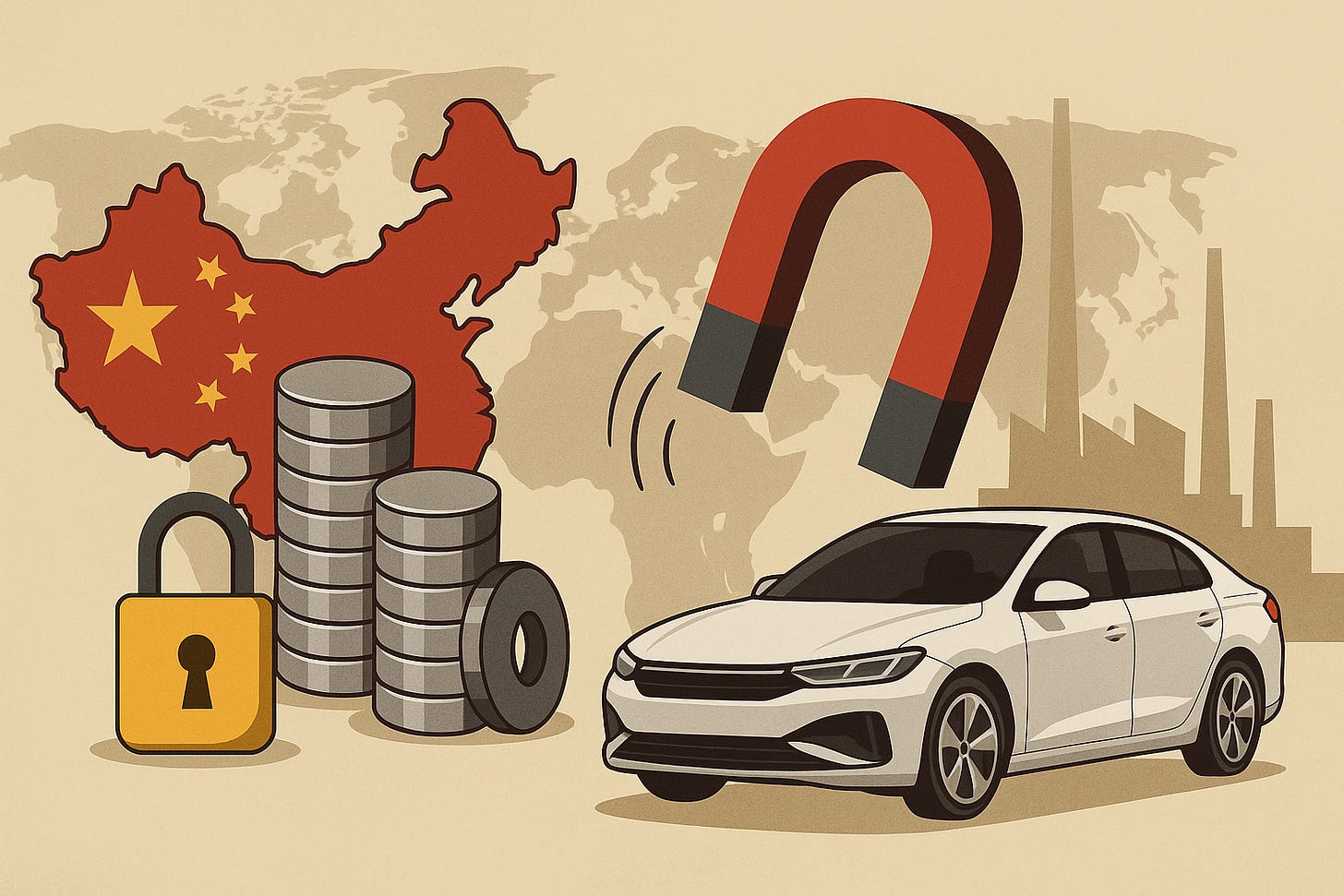Why the World Is Waking Up to Rare Earths — and Why India Should Too
Issue #20 Inside the Global Tug-of-War Over the Metals That Power Modern Life
You’ve probably heard the buzz: “China restricts rare earth exports”… “EV makers sound the alarm”… “Global magnet shortage ahead.”
It might sound over the top — but this time, the headlines aren’t exaggerating. Let’s break it down.
What Are Rare Earths — And Why Should We Care?
Despite the name, rare earths aren’t really rare. They’re a group of 17 metallic elements found across the Earth’s crust. But here’s the tricky part — they rarely occur in concentrated deposits, and extracting and refining them is expensive, messy, and often toxic.
So why are they so important?
Because they’re the invisible backbone of modern technology — especially magnets. These super-strong rare earth magnets power the motors in electric vehicles (EVs), wind turbines, smartphones, fighter jets, and even your car’s speakers and window motors.
Quick stat: A single EV uses 1–2 kg of rare earth magnets. Without them, electric motors don’t work.China’s Tightening Grip — And the World’s Growing Anxiety
China controls the rare earth game — and not just a little.
Mines 70% of global rare earths
Refines 90% of global supply
Produces a staggering 92% of rare earth magnets
In April 2025, China made things even tighter. It imposed stricter export controls, especially on heavy rare earths used in EVs and advanced electronics. Any export now requires a special license based on end-use, and approvals have slowed drastically — especially for countries like India.
Result?
Rare earth magnet exports from China fell 15% in April alone. Automakers worldwide — from Ford and Toyota to Tata Motors and Bajaj — are now sitting on just 6–8 weeks of magnet inventory.
If shipments don’t resume, production halts could begin as early as July 2025.Why India’s Auto Sector Is in the Hot Seat
India’s EV story was finally getting into gear:
Tata’s EV arm swung into profitability in FY25, posting a 1.2% margin (vs. -7.1% in FY24).
Mahindra’s new electric SUVs turned breakeven in just one quarter.
Hyundai’s Creta EV is seeing strong early traction.
But now, the party might pause.
Here’s how different vehicle segments are impacted:
Low impact: ICE 2-wheelers and 3-wheelers — rare earth use is minimal.
Medium impact: Electric scooters — some motors use magnets (~Rs 150 worth) ; possible to re-engineer in 2–3 months.
High impact: EV passenger cars — dozens of components rely on heavy rare earth magnets. Replacing or redesigning isn’t quick or easy.
Buses: Also impacted, though they offer more design flexibility due to size.
And with the festive season starting September 2025, timing couldn’t be worse.India’s Rare Earth Problem: Resources, But No Readiness
Here’s the twist: India has 7 million tonnes of rare earth reserves — the 5th largest globally.But in 2023, we produced just 2,900 tonnes. That’s less than 1% of global output. Why?
Most mining is done by IREL (India Rare Earths Ltd) — a PSU historically focused on nuclear materials.
Private players have been kept out of exploration.
We lack refining and magnet-making capacity.
Even IREL’s Vizag plant can make only 3 tonnes of SmCo magnets a year — not enough for even one EV model.
Exploring and developing new mines will take 5–6 years, even with fast-tracking.
What India (and the World) Is Doing Now
This rare earth crunch has governments and industries scrambling.
Global Moves:
U.S. reopened the Mountain Pass mine and is funding rare earth supply chains.
EU launched 47 diversification projects.
Australia’s Lynas is expanding capacity.
Japan is recycling magnets from e-waste.
India’s Response:
Launched the Critical Minerals Mission
Auctioned new exploration blocks
Working to open rare earths to private players
Component makers (15–16 of them) have applied for Chinese approvals; 8–9 are still waiting
But many firms are also exploring importing assembled motors from China — though this might violate the PLI scheme’s local value-addition norms.
Meanwhile, startups like GTEC and Sterling are working on magnet-free motors, and some OEMs are eyeing ferrite-based motors — though performance trade-offs exist.
This Is Bigger Than Just Magnets
This rare earth standoff reveals a bigger truth:
The world’s clean tech revolution depends on a few niche materials — and one country’s monopoly can stall everything from cars to defense.
Even the U.S. defense sector is nervous. Fighter jets, missile systems, radar — all rely on rare earth magnets.
And India?
We can’t afford to sit back. Our EV goals, FAME subsidies, Atmanirbhar ambitions — all depend on securing inputs like rare earths, batteries, and semiconductors.
Today it’s magnets. Tomorrow, it might be battery metals or something else entirely.
What’s Next?
In short:
Q1 FY26 (Apr–Jun): Still manageable.
Q2 FY26 (Jul–Sep): Could see real pain — delays, lower EV output, and missed festive volumes.
Long term: India must invest — fast — in rare earth mining, refining, and alternative technologies.
Diplomacy might still resolve current approvals. But systemic change needs more than hope — it needs policy, private participation, and speed.
The Bottom Line
We’re not in a full-blown crisis — yet.
But this is a loud, sharp wake-up call for India and the world. We’re too dependent on one country for critical materials that drive the future of mobility, energy, and security.
India has the reserves. We have the talent. And we certainly have the demand.
What we need now is urgency.
Because the EV revolution isn’t waiting — and neither is China.
If this helped you understand the rare earth story better, do share it with a friend — especially if they’re into EVs, geopolitics, or tech investing. This one’s not just another headline — it’s the story under the surface, and it’s unfolding fast.
—
Priyank






